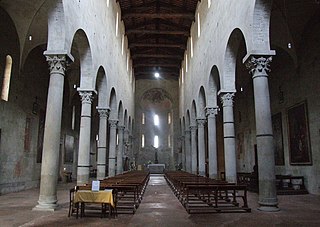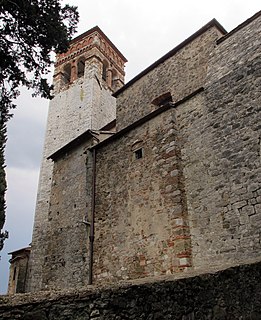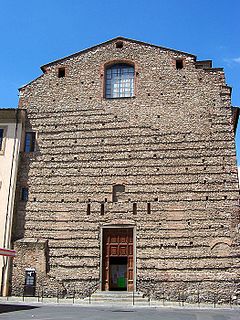
Pistoia (, Italian: [pisˈtoːja] is a city and comune in the Italian region of Tuscany, the capital of a province of the same name, located about 30 kilometres west and north of Florence and is crossed by the Ombrone Pistoiese, a tributary of the River Arno. It is a typical Italian medieval city, and it attracts many tourists, especially in the summer. The city is famous throughout Europe for its plant nurseries.

Santa Maria in Vallicella, also called Chiesa Nuova, is a church in Rome, Italy, which today faces onto the main thoroughfare of the Corso Vittorio Emanuele and the corner of Via della Chiesa Nuova. It is the principal church of the Oratorians, a religious congregation of secular priests, founded by St Philip Neri in 1561 at a time in the 16th century when the Counter Reformation saw the emergence of a number of new religious organisations such as the Society of Jesus (Jesuits), the Theatines and the Barnabites.

Giovanni Stefano Marucelli was an Italian painter and architect of the Baroque period, active in Tuscany, including Florence and Pisa.

San Paolo is a Roman Catholic church located on Via della Rosa #39 in Pistoia, region of Tuscany, Italy. The eclectic church facade sits near the intersection of four streets: Corso Silvani Fedi, Corso Giovanni Amendola, Via Porta Carratica, and Via del Can Bianco, about a block away along Silvani Fedi from the Chiesa del Tau.

Pistoia Cathedral, or Cathedral of Saint Zeno is the main religious building of Pistoia, Tuscany, central Italy, located in the Piazza del Duomo in the centre of the city. It is the seat of the Bishop of Pistoia and is dedicated to Saint Zeno of Verona.

San Bartolomeo in Pantano is a Romanesque and Gothic style, Roman Catholic church in Pistoia, Tuscany, central Italy, dedicated to St. Bartholomew the Apostle. The pantano of the name refers to the once marshy area in which the building was located.

San Giovanni Fuoricivitas is a Romanesque religious church and adjacent buildings in Pistoia, Tuscany, central Italy. The adjective fuoricivitas refers to it location, outside of the first set of city walls, when it was founded during the era of Lombard rule in Italy.

The Basilica of Our Lady of Humility or Madonna dell'Umiltà is a Renaissance-style, Roman Catholic Marian basilica in Pistoia, region of Tuscany, Italy.

San Francesco is a Gothic-style, Roman Catholic church located in front of the square named after the church, in the historic center of Prato, region of Tuscany, Italy.

San Filippo Neri is a Baroque church on via Lomellini in central Genoa. The order of the Oratory of Saint Philip Neri had arrived in Genoa in 1643, under the sponsorship of the Oratorian and Marchese Camillo Pallavicini who was born in Genoa. Originally housed in the church of San Pancrazio, by 1674 the order began a move to this new site and built their church and chapter house on the site of a former palace of the Lomellino family.

Santa Croce is a Roman Catholic church located on Corso Vittorio Emanuele 178 in Padua, Veneto region, Italy.

San Filippo Neri is a late-Baroque style, Roman Catholic church located in Turin, region of Piedmont, Italy. The church is located on Via Maria Vittoria 5; the left flank of the nave faces the Turin Academy of Sciences. The church is still used for services. 69 metres (226 ft) long and 37 metres (121 ft) wide, it is the largest church in the city of Turin.

Ferrara Charterhouse, of which the present Church of San Cristoforo alla Certosa was previously the monastic church, is a former charterhouse or Carthusian monastery built in Renaissance style, located on Piazza Borso 50 in Ferrara, Region of Emilia-Romagna, Italy. The monastery was suppressed in the time of Napoleon, but the church was reconsecrated in 1813 and remains in use. The site also accommodates a large municipal cemetery, which was established in 1813.

San Giovanni Battista Decollato is a renaissance-style, Roman Catholic rural parish church located in the Borgo della Rocca of town of Montemurlo, province of Prato, region of Tuscany, Italy.

San Michele e San Francesco is a renaissance-style, Roman Catholic parish church located in the Piazza SS Francesco e Michele in the town of Carmignano, province of Prato, region of Tuscany, Italy. It is best known for housing the Jacopo Pontormo altarpiece of the Visitation.

The Fioravanti family were a noble family originating in Pistoia in Tuscany and active in Florence and other Italian towns. They were Guelf in their politics and naturally allied with the Cancellieri family and adversaries of the Ghibelline Panciatichi family. An early record dates to 1267, when Fioravanti d'Accorso was a member of the town council. In 1310 Ranieri, his son, was Mayor of the Pistoia. In 1319 Simone di Ranieri was a member of the elders. Giovanni di Puccio di Ranieri Fioravanti was a banker active at the court of Pope Clement V (1305-1314) in Avignon. Andrea di Simone di Baldo Fioravanti was elected Capitano della Montagna Superiore, June 17, 1354. Francesco di Rinieri was the Gonfaloniere of the Florentine Republic in the years 1385 and 1389: Neri his son was also Gonfaloniere in 1428; Fioravanti di Piero was the Cavalry Captain in Flanders in 1510 and then for Pope Alessandro VI, commissioner at Assedius of Faenza: Vincenzo di Cipriano one of the first to be elected knight of Santo Stefano, in 1576, shortly after the establishment of that military order, and later Chancellor of the Order: Fabio of Cipriano, was Cavalry Captain in the Netherlands: Alberto di Fioravanti Knight of Malta in 1590, and Commendatore in 1610: Niccolao di Fioravanti captain in the emperor Ferdinand II against the King of Sweden in 1636, and in 1643 in Tuscany for the Grand Duke against the Barberini.

Ognissanti is a 16th-century Roman Catholic church located in the Dorsoduro sestiere of the Italian city of Venice.

Santo Spirito, once called the church of Sant'Ignazio, is a Roman Catholic church in Pistoia, region of Tuscany, Italy.

The church and convent of the Santissima Annunziata is a Baroque-style, Roman Catholic church located on Piazza de Servi #4, Pistoia, region of Tuscany, Italy. The convent presently functions as a warehouse. The church is down via Laudesi from the San Desiderio, and via Piazza de Servi, From San Giovanni Decollato.

The Oratory of San Desiderio is a prayer hall located on Via Laudesi #53 in Pistoia, region of Tuscany, Italy. It houses 16th century paintings by Sebastiano Vini, Domenico Cresti, Francesco Curradi, and Matteo Rosselli. The oratory is diagonally across from the apse of Santa Maria Nuova.
























